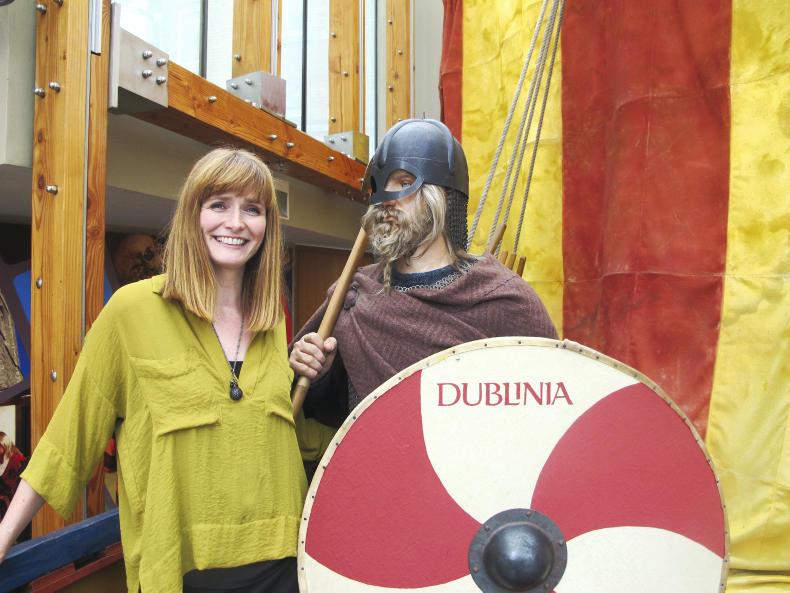One would never imagine that spending an afternoon exploring the past of ancient Ireland, learning about the lives of our farming forefathers – and even dressing up as a Viking warrior – would be such a memorable experience.
Irish Country Living went along to the Viking and medieval tour at Dublinia museum, where we met up with Kilkenny native Sheila Dooley, who has been the education curator of Dublinia for the last eight years. A graduate of history and archeology, her passion for our ancient ancestors is infectious and has seen her carve a career revolving around Irish medieval history.
“My family was always passionate about Irish history and I suppose that passion passed down to me. Growing up in Kilkenny we would always have the ‘Sunday drive’, which would oftentimes consist of a family day out to some of Ireland’s idyllic ancient castles,” admits Sheila.
As education curator, Sheila is equally passionate about creating an interactive learning experience where visitors can submerge themselves in the era of medieval Ireland, with the ethos of “learn to have fun”.
Indeed, to inspire and educate children, Dublinia has set-up an interactive website to help students to uncover stories and facts of medieval times.
“Around 160,000 visitors from all corners of the world would arrive on the steps of Dublinia each year to connect with and understand the past of Ireland. Given that a large proportion of those visitors are students, we aim to provide an educational experience where kids can provoke imagination and have fun but sneakily learn at the same time,” says Sheila.
In medieval farming, according to Sheila, farmers were the “backbone” of the economy and “kept Ireland alive in the medieval period”.
Farmers would be based in community settlements in the hinterland. The average farmer would have a small acreage of land and would grow common crops such as barley and wheat, while rearing a small number of animals including pigs, sheep and cows. The food produced on the farm fed the family, but any excess produce would be bartered with the various traders in nearby towns, including the capital.
“Dublin was based on a trade society, which meant the success and survival of the city depended upon the crafts and food produced by the farming community,” says Sheila
However, even though farmers were crucial for preserving a prosperous economy, the average farmer was regarded as inferior in the social class hierarchy and endured a laborious and grueling lifestyle.
“In an era of untold cattle raiding, violence and war, the work of a farmer was exceptionally strenuous and often quite challenging. They obviously didn’t have any state-of-the-art machinery like modern-day farms but instead they had oxen which were essential for land cultivation and transporting bulky objects,” explains Sheila.
Despite the importance of women in medieval farming, they were underrepresented and overshadowed by their husbands, says Sheila. Farming wives and mothers were key to the overall functioning of the domestic household and the family farm. She would be responsible for nurturing her children, preserving and cooking food and helping out with livestock and crop management.
Children in farming families were often deprived of a childhood. Boys and girls as young as eight would be expected to work either on the farm or manage the housework. Children in medieval farming families were also subjected to wearing dull-coloured clothes to differentiate themselves from royal children. Only children who had a prestigious family pedigree were allowed to wear colourful garments.
But even though medieval Ireland could be quite dreary, farm families made sure to have fun along the way too.
Great festivals were held to celebrate harvests and seasons, which would see all members of society, regardless of social status, congregating together to mark the special occasion. These festivals would last for days and there would be copious amounts of food, plenty of horse racing and gambling with the occasional alcoholic beverage. Marriages and alliances would be arranged at these festivals and would see families ending lifetime quarrels and creating new beginnings.
The medieval period was certainly an adventurous time for our farming ancestors. Yet, many farming practices and medieval rituals have been passed on from generation to generation, which have been developed and enhanced into modern-day farming.
“I definitely find the medieval era to be the most interesting time in Irish history. In saying that, I do believe it’s important for everyone to be aware of our past in order to truly understand our native heritage,” says Sheila.
Dublinia is located on St Michael’s Hill, Christchurch, Dublin 8. Admission for Dublinia’s self-guided tour is €8.50 for adults and €5.50 for children. For further information, see www.dublinia.ie or contact 01-679-4611.






 This is a subscriber-only article
This is a subscriber-only article










SHARING OPTIONS: